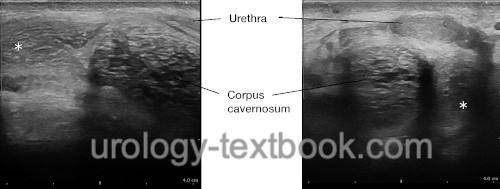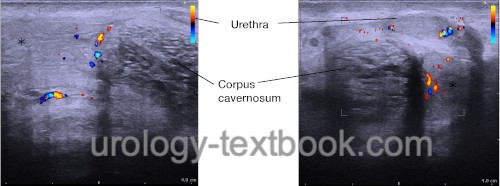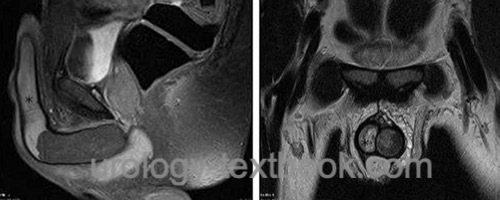You are here: Urology Textbook > Penis > Partial Thrombosis of the Corpus Cavernosum
Partial Thrombosis of the Corpus Cavernosum
Definition:
Partial thrombosis of the corpus cavernosum is a rare and etiologically unclear condition; it affects young men around 30 years of age (Goeman et al., 2003).
Etiology of Partial Thrombosis of the Corpus Cavernosum
The cause of the thrombosis is unclear. Imaging or surgery often reveals a membrane in the corpus cavernosum, which delineates the thrombosis distally. Perineal compression, like cycling, is seen as a provocative factor (Weyne et al., 2015).
Signs and symptoms:
The patient reports perineal pain and swelling. Erectile function is usually preserved. Examination reveals unilateral painful enlargement of the proximal corpus cavernosum.
Diagnosis:
- Perineal ultrasound imaging [fig. perineal ultrasound imaging] with Doppler sonography [fig. Dopplerultrasound]
- CT or MRI [fig. MRI imaging of partial thrombosis] if findings are equivocal.
- Laboratory testing regarding hypercoagulopathy is indicated.
 |
 |
 |
Treatment of Partial Thrombosis of the Corpus Cavernosum
Older treatment recommendations favored surgery for partial thrombosis of the corpus cavernosum: perineal exposure of the corpus cavernosum, evacuation of the thrombosis, and resection of the above mentioned membrane. Current publications favor conservative measures: systemic anticoagulation for several months in combination with NSAIDs for initial pain therapy leads to a reasonably good outcome regarding symptoms and erectile function. The resolution of the thrombosis should be monitored with imaging. Surgery is an option for refractory cases.
| Frenulum breve | Index | Urethral stricture |
Index: 1–9 A B C D E F G H I J K L M N O P Q R S T U V W X Y Z
References
Goeman, L.; Joniau, S.; Oyen, R.; Claes, H. & Poppel,
H. V.
Idiopathic partial thrombosis of the corpus cavernosum:
conservative management is effective and possible.
Eur Urol, 2003,
44, 119-123
E. Weyne, C. Schillebeeckx, C. Jamaer, and D, “Idiopathic Partial Thrombosis (IPT) of the Corpus Cavernosum: A Hypothesis-Generating Case Series and Review of the Literature.,” J Sex Med., vol. 12, no. 11, pp. 2118–2125, 2015.
 Deutsche Version: Ursachen, Diagnose und Therapie der partiellen Schwellkörperthrombose
Deutsche Version: Ursachen, Diagnose und Therapie der partiellen Schwellkörperthrombose